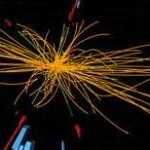 Researchers at CERN laboratory in Switzerland announced this week that they believe they have evidence of the existence of the Higgs boson, or Higgs particle. The Higgs boson and the associated Higgs field help to explain, among other things, how particles achieve mass. In 1964 physicist Peter Higgs and five other researchers theorized the Higgs boson. Researchers at CERN have been colliding particles in the Large Hydron Collider to look for the Higgs boson.
Researchers at CERN laboratory in Switzerland announced this week that they believe they have evidence of the existence of the Higgs boson, or Higgs particle. The Higgs boson and the associated Higgs field help to explain, among other things, how particles achieve mass. In 1964 physicist Peter Higgs and five other researchers theorized the Higgs boson. Researchers at CERN have been colliding particles in the Large Hydron Collider to look for the Higgs boson.
The Higgs boson is part of the Standard Model theory, which explains the interactions and characteristics of subatomic particles. Researchers had accounted for the Higgs boson in their Standard Model calculations over the years. In November 2011, a CERN physicist said, “’For our theory to be right, we need the Higgs to exist. If it doesn’t, we need something to replace it.’” The question now appears to be what kind of Higgs boson researchers have observed.
Reading about the Higgs boson announcement reminded me of Professor Lawrence Tribe’s book The Invisible Constitution. The Higgs boson and the United States Constitution don’t at first glance have much in common, but the way Tribe approaches interpreting the Constitution parallels the approach of theoretical physicists in creating models that explain the invisible rules that govern the physical universe. In fact, Tribe himself draws an analogy to physics throughout the book.
The Constitution, Tribe asserts, is both visible and invisible. The visible Constitution is the text of the Constitution. The invisible Constitution is what is “’in’” it, “but cannot be seen when one reads only its text.” 13.
[I]t seems obvious that we must have an invisible Constitution as well as a visible one: it’s the invisible Constitution that tells us what text to accept as the visible Constitution of the United States, as well as how much force to ascribe to the text. 7.
The invisible Constitution has also been discussed on the Marquette blog in an earlier series here, here, here, here, and here.
The analogy to physics in The Invisible Constitution is not surprising in that Tribe majored in mathematics as an undergraduate. Tribe does something that many really good physicists (and mathematicians) do—he visualizes models. Visualization allows complex ideas to be simplified so they can be dealt with. Einstein also was good at this visualizing process.
Tribe identifies six “modes of construction”, which he says “reflects [his] sense of how best to conceptualize the mental process involved in identifying (and, at times, self-consciously shaping) elements of the constitutional landscape.” 155-56. Tribe names these modes geometric, geodesic, global, geological, gravitational, and gyroscopic. 155. He includes his own full-color drawings of each mode of construction because they “reflect [his] attraction to paradox (here the paradox of using visual materials to describe what is invisible in the Constitution) and [his] distinctly ‘right-hemisphere’ way of thinking of legal (and other) materials.” 156.
What makes thinking about law, science, or math engaging is that a person can, as Tribe notes, solve puzzles. 211. There is a thrill in resolving seemingly inconsistent rules of law that matches the joy of solving an especially difficult math problem. A compliment in physics or mathematics is to call a solution elegant.


Here’s another exciting development in the world of physics: the big bang theory.